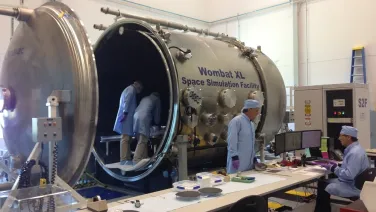One giant leap for astronomy: new telescope sets sights on the Universe’s deepest galaxies

Astronomers around the world are celebrating an announcement from the European Union that they will fund development of a concept for an ‘ultimate survey telescope’ in Chile.
Called the Wide-field Spectroscopic Telescope (WST), the ambitious new facility aims to be operational by 2040 and will allow astronomers to survey galaxies throughout the Universe for the first time.
“At the moment, we can survey galaxies back to midway through the Universe's history, but we only see small numbers of galaxies at earlier times. But with this telescope will be able to survey vast numbers of galaxies all the way back to basically when galaxies were first being built,” says Professor Matthew Colless from the ANU Research School of Astronomy and Astrophysics.
“This may be the last big survey telescope the world’s going to need, because after this - there ain’t no more galaxies to see.”
Nineteen research institutions, including ANU, are part of the consortium that has received funding to develop the concept, which is hoped to be the next big telescope for the European Southern Observatory.
“Besides the obvious astronomical research opportunities, it's also a huge opportunity for Australian industry and our strategic partnership with the European Southern Observatory,” Professor Colless says.
“Australia will be heavily involved in this project, and ANU in particular will be leading the work on the design of both the telescope structure and its instrumentation.”
The WST will fulfil a critical need identified by the international scientific community for a telescope with a primary mirror bigger than ten metres in diameter exclusively dedicated to the spectroscopic observations of celestial sources.

“It's something astronomers have been wanting for a really long time in order to tackle some of our biggest questions,” Professor Colless says.
“Right now, with the James Webb Space Telescope or the big ground-based telescopes, you can see individual galaxies right back to their beginnings, but you're only seeing a handful.
“We're planning to look at tens or hundreds of millions of galaxies, not only to understand how individual galaxies work, but to understand how the whole population evolves.
“More importantly, we’ll also be able to see how really large-scales structures traced by individual galaxies grow over time. That tells us where all the dark matter is in the Universe, and how much of it there is, and also how galaxies respond to gravity on very large scales.
“Although we've tested Einstein’s General Relativity with great precision on planetary and interstellar scales, we haven't tested it with real precision on scales that approach the scale of the whole visible Universe.”
The consortium leading the WST project will receive three million euros from the European Union’s Horizon Europe Framework Program to fund the study over the next three years.
For more information, contact:
Professor Matthews Colless
ANU Research School of Astronomy and Astrophysics
0431 898 345
Associate Professor Tony Travouillon
ANU Research School of Astronomy and Astrophysics
(02) 6125 8030



